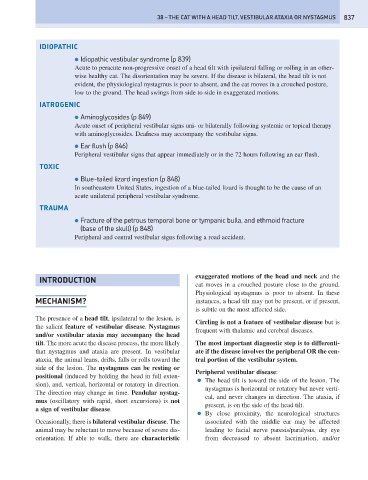Page 845 - Problem-Based Feline Medicine
P. 845
38 – THE CAT WITH A HEAD TILT, VESTIBULAR ATAXIA OR NYSTAGMUS 837
IDIOPATHIC
● Idiopathic vestibular syndrome (p 839)
Acute to peracute non-progressive onset of a head tilt with ipsilateral falling or rolling in an other-
wise healthy cat. The disorientation may be severe. If the disease is bilateral, the head tilt is not
evident, the physiological nystagmus is poor to absent, and the cat moves in a crouched posture,
low to the ground. The head swings from side to side in exaggerated motions.
IATROGENIC
● Aminoglycosides (p 849)
Acute onset of peripheral vestibular signs uni- or bilaterally following systemic or topical therapy
with aminoglycosides. Deafness may accompany the vestibular signs.
● Ear flush (p 846)
Peripheral vestibular signs that appear immediately or in the 72 hours following an ear flush.
TOXIC
● Blue-tailed lizard ingestion (p 848)
In southeastern United States, ingestion of a blue-tailed lizard is thought to be the cause of an
acute unilateral peripheral vestibular syndrome.
TRAUMA
● Fracture of the petrous temporal bone or tympanic bulla, and ethmoid fracture
(base of the skull) (p 848)
Peripheral and central vestibular signs following a road accident.
exaggerated motions of the head and neck and the
INTRODUCTION
cat moves in a crouched posture close to the ground.
Physiological nystagmus is poor to absent. In these
MECHANISM? instances, a head tilt may not be present, or if present,
is subtle on the most affected side.
The presence of a head tilt, ipsilateral to the lesion, is
Circling is not a feature of vestibular disease but is
the salient feature of vestibular disease. Nystagmus
frequent with thalamic and cerebral diseases.
and/or vestibular ataxia may accompany the head
tilt. The more acute the disease process, the more likely The most important diagnostic step is to differenti-
that nystagmus and ataxia are present. In vestibular ate if the disease involves the peripheral OR the cen-
ataxia, the animal leans, drifts, falls or rolls toward the tral portion of the vestibular system.
side of the lesion. The nystagmus can be resting or
Peripheral vestibular disease:
positional (induced by holding the head in full exten-
● The head tilt is toward the side of the lesion. The
sion), and, vertical, horizontal or rotatory in direction.
nystagmus is horizontal or rotatory but never verti-
The direction may change in time. Pendular nystag-
cal, and never changes in direction. The ataxia, if
mus (oscillatory with rapid, short excursions) is not
present, is on the side of the head tilt.
a sign of vestibular disease.
● By close proximity, the neurological structures
Occasionally, there is bilateral vestibular disease. The associated with the middle ear may be affected
animal may be reluctant to move because of severe dis- leading to facial nerve paresis/paralysis, dry eye
orientation. If able to walk, there are characteristic from decreased to absent lacrimation, and/or

